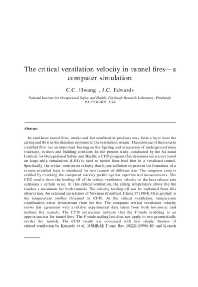Mining Publication: The Critical Ventilation Velocity in Tunnel Fires - A Computer Simulation
Original creation date: April 2005
In ventilated tunnel fires, smoke and hot combustion products may form a layer near the ceiling and flow in the direction opposite to the ventilation stream. The existence of this reverse stratified flow has an important bearing on fire fighting and evacuation of underground mine roadways, tunnels and building corridors. In the present study, conducted by the National Institute for Occupational Safety and Health, a CFD program (fire dynamics simulator) based on large eddy simulations (LES) is used to model floor-level fires in a ventilated tunnel. Specifically, the critical ventilation velocity that is just sufficient to prevent the formation of a reverse stratified layer is simulated for two tunnels of different size. The computer code is verified by checking the computed velocity profile against experimental measurements. The CFD results show the leveling-off of the critical ventilation velocity as the heat release rate surpasses a certain value. At this critical ventilation, the ceiling temperature above the fire reaches a maximum for both tunnels. The velocity leveling-off can be explained from this observation. An extended correlation of Newman (Combust. Flame 57 (1984) 33) is applied to the temperature profiles obtained by CFD. At the critical ventilation, temperature stratification exists downstream from the fire. The computed critical ventilation velocity shows fair agreement with available experimental data taken from both horizontal and inclined fire tunnels. The CFD simulations indicate that the Froude modeling is an approximation for tunnel fires. The Froude-scaling law does not apply to two geometrically similar fire tunnels. The CFD results are compared with two simple theories of critical ventilation by Kennedy et al. (ASHREA Trans. Res. 102(2) (1996) 40) and Kunsch (Fire safety J. 37 (2002) 67).
Authors: CC Hwang, JC Edwards
Peer Reviewed Journal Article - April 2005
NIOSHTIC2 Number: 20026680
Fire Saf J 2005 Apr; 40(3):213-244
See Also
- CFD Modeling of Smoke Reversal
- Development and Application of Reservoir Models and Artificial Neural Networks for Optimizing Ventilation Air Requirements in Development Mining of Coal Seams
- MFIRE - 3.0.50
- MFIRE Users Manual Version 2.20
- Modeling and Prediction of Ventilation Methane Emissions of U.S. Longwall Mines Using Supervised Artificial Neural Networks
- New Improvements to MFIRE to Enhance Fire Modeling Capabilities
- Responders to Underground Mine Fires
- Safety Aspects of Mine Ventilation Through Technical Development and Training
- Specialized Fortran Computer Programming and Analysis Services to Upgrade Capability of MFIRE Program
- Study of Mine Fires and Mine Ventilation: Part I, Computer Simulation of Ventilation Systems Under the Influence of Mine Fires
- Content source: National Institute for Occupational Safety and Health, Mining Program


 ShareCompartir
ShareCompartir
